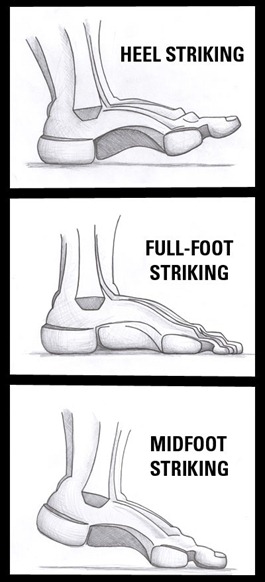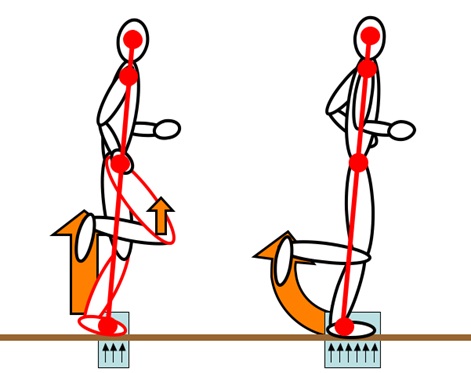By Amanda Brooks
Ever feel like there is an endless loop of things you should be doing to get better at running?So much so that you throw your hands up {not in the party way} decide to ignore it all and just go run?
After 15 years running, I’ve digested the assorted recommendations, eliminated the quacktastic one’s and settled on a few tweaks for running injury free without added stress. One of the most important is how to run properly!
Summon your inner child and get ready to be a STAR performer.
These simple tweaks do not require you to change your stride, pick new shoes or add time to the workout. One of the issues I have with so many running form recommendations is they want you to stray from your natural stride.
We all run a little bit differently and it turns out that’s ok.
“Many people are advocating for various ‘optimal’ running forms, but this study (in the International Journal of Exercise Science) shows even novice runners shouldn’t try to run any different than their body naturally does,” study co-author and USA Track & Field consultant Iain Hunter said in a press release.
Enjoy running, and worry less about what things look like.”
Basically the study proved that when you try to lengthen or shorten your stride to fit a “perfect ideal” you end up using a lot more energy! So instead of focusing on how far to move your legs, let them flow and think about these little running mechanics instead.
Here I demo tips for how to correct running form, but you can also read more on them below!
4 Simple Tips to Improve Running Form
During each run, spot check your form these 4 running form tips {trying doing it after every 2-3 songs}.
SHOULDERS
For most people one of the first places to noticeably feel tension is the shoulders, if yours are beginning to resemble earrings it’s time to relax.
- Take a deep breathe and sigh, you should feel your shoulders drop immediately
- Throughout the run do this to eliminate energy wasted in shoulder tension
- Dropped shoulders will open your chest up for better breathing
TALL
As we begin to fatigue our natural inclination is to slouch thinking that we are letting our body relax. This curved body position makes running harder because you are not engaging the core, tightening the lungs and effecting you mentally. Running posture is much like good posture the rest of the time! You want shoulders down, head high and core tightened.
- Pull up from the top of your head
- Stretch your arms diagonally up to help you stand tall, chest forward with just a slight lean
- Chin parallel to the ground look forward, not down at your feet
- Standing tall increases energy through better breathing and a body feeling that creates confidence
ARMS
Holding your arms against your sides requires 12% more energy than letting them naturally swing…since I’m sure none of you do that here are a few arm movement tips to keep you from swinging across the body or too hard, both of which can lead to IT band and other injuries.
Long distance running form is different than sprinters. While they need to pump their arms fiercely through a full swing, distance runners are conserving energy with small movements (see video).
- Hold a butterfly wing between your thumb and pointer finger
- Hands in a light fist with palms facing towards your body
- Thumb tip is thus pointed forward and the thumb knuckles towards the sky
- This hand placement helps to prevent cross body arm swing, which is an injury magnet
- Arms should stay bent roughly 90 degrees, forward and back
RELAX
How can you tell when someone is really concentrating? Their eyes narrow, their brow furrows and maybe even their lips purse…all of this might be great for communication, but on the run it’s lots of wasted energy that could be used for propelling you forward and farther
- say to yourself “relax, let go” a few times during a hard effort
- muscles you didn’t realize you were tense release and the effort becomes much easier
- relaxed muscles respond with an easier turn over, better stride and less wasted energy
Other notable tips:
- Running stride is not about lengthening your stride, rather it’s about quickening your turn over so your feet land right under you.
- Don’t bounce. Imagine the ceiling is an inch above you and you don’t want to hit it.
- Flat feet. Don’t run like you are wearing heels, it can help for a while to imagine flexing your foot and landing on the whole foot
- Slight lean. A tall stance with a slight forward lean will prevent you from major heel striking.
- Aim for a cadence of 180 footfalls per minute (more on this in how to learn pacing)
What about foot fall?
While I don’t want you to get too in your head with running form, I know this is an area with a lot of questions. Is there a best running form for how we strike the ground.
Yes.
Is it on the ball of our foot, instead of the heel? No, not exactly.  We’ve figured out that heel striking is a no go. When you land with your heel first, it acts like a brake sending a shock all the way up your leg and through your spine. Imagine doing that thousands of times in a single run and you start to see why it could result in knee, hip and back pain.
We’ve figured out that heel striking is a no go. When you land with your heel first, it acts like a brake sending a shock all the way up your leg and through your spine. Imagine doing that thousands of times in a single run and you start to see why it could result in knee, hip and back pain.
In fact, heel striking is probably one of the biggest reasons people swear they can’t run because it hurts. Yeah, it hurts when you’re doing it horribly wrong. People are generally heel striking because they’re stretching their legs out super long with the idea that is how you run faster.
It’s not.
You run faster by picking your feet up off the ground more rapidly and leaning slightly in to your forward motion. AH HA. Instead of braking, you being to take advantage of gravity.
All right, back to your foot fall. You DO NOT want to be running on your toes, in other words trying to land on the ball of your foot and keeping your calves engaged for the entire run.
- Land with your foot directly below your body (practice marching in place to see how that feels)
- You will use your entire foot for the most force (think of it like pawing the ground)
- It can help to think about flexing your foot initially to get to a more natural footfall instead of heel or ball
- Eventually as that becomes comfortable you will start to land around your mid-foot which is ideal

Some people refer to this idea as ChiRunning, which is a whole concept of relaxed running that honestly can get a little convoluted if you try to dig in to it too much.
Overall, you want to find a way to run that’s relaxed and eliminates some of the key twisting or striking motions that can cause injury.
This article was first published on https://www.runtothefinish.com/4-simple-tips-to-improve-running-form/
